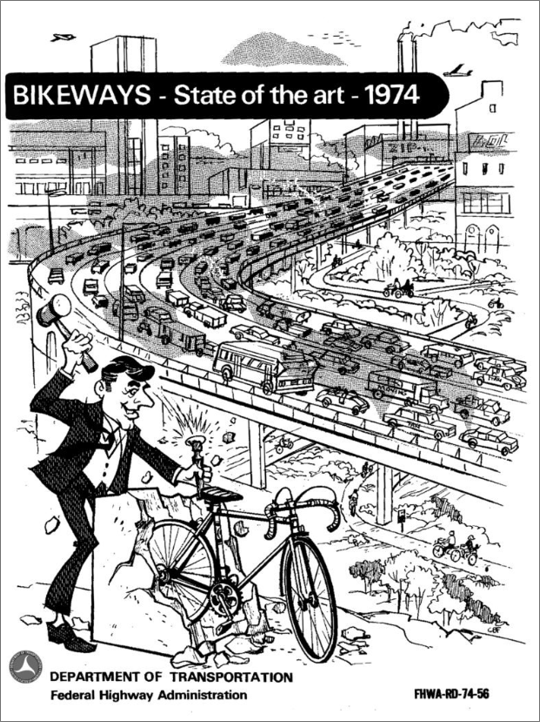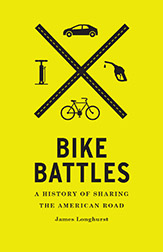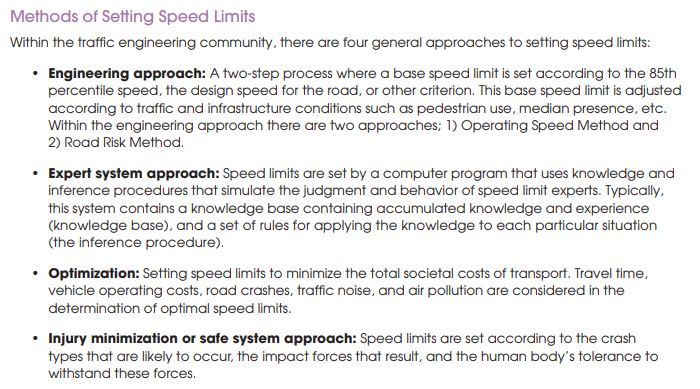The 12 Days of Safety Myths
December 20, 2018
By Don Kostelec
The idea for the 12 Days of Safety Myths came to me a few weeks ago while I was riding my bike home along the Boise River Greenbelt. The goal was to debunk the common statements heard in the transportation world that serve to limit progress on safer infrastructure for walking and bicycling.

The 10th day is a potpourri of items illustrating how the Federal Highway Administration (FHWA) is a misunderstood organization, by both transportation agencies that look up to them and the public who advocates for safer walking and bicycling investments.
Centralized Road Authorities & “Highways”
The great irony in the active transportation world’s frustration with the Federal Highway Administration is that our active transportation forebears helped create it. James Longhurst’s book Bike Battles is a great publication that chronicles the history of the bicycling world’s efforts at transportation legitimacy stemming from their early organizing efforts in the 1800s.
Roads outside of cities were maintained primarily by farmers at that time. They got around to grading them when their work schedule or seasonal conditions permitted. The bicyclists who desired to escape the cities for recreational riding found a mishmash of conditions on these muddy, rutted rural routes.
In their push for paving of these rural routes along with pursuing rights to operate in the road, bicyclists were a leading group organized to advocate for centralized road authorities. These authorities would bring about more consistent conditions and construct “high ways,” or routes purposely engineered to sit higher than the surface level of the land, thus facilitating easy drainage, a weather-resistent surface, and movement of water to the sides of them.
Longhurst’s book notes that the “high way in English tradition was a road or path on which travelers were permitted free and unencumbered passage across property that was owned or controlled by others.”

How many times have your heard someone say, “It’s a highway, not a bike way! Highways are for cars!” We’ve completely bastardized the definition of a highway over the years.
If we take the modern definition of a highway as being a traveled route purposely engineered to withstand a variety of weather conditions, and combine it with the traditional English definition, then we easily discern that any traveled way–a sidewalk, a greenway, a protected bike lane–is by definition a highway.
Federal Highway Administration
Now that it’s clear that FHWA, by historical definition, is there to help promote safe movements on highways, let’s address how it’s misunderstood.
Just as AASHTO publishes “guidance” rather than “standards,” so does FHWA. It’s nearly impossible to find the words “shall” or “must” in FHWA’s published reports. The word “should” is prevalent across the wide spectrum of their transportation literature.
As we already know, it’s certainly not interpreted as being so flexible when it comes to transportation departments using FHWA’s publications and supported efforts to justify wider roads for cars at the expense of safety for people who walk and bike.
However, if you look closely, you’ll find ample support from FHWA for things like veering away from strictly applying the 85th percentile rule to set speed limits. They also provide a lot of documentation to support equitable treatment of people who walk and bike. They state that any sidewalk or bicycle project built with federal funds should be maintained during snowstorms and other weather to the same degree as the adjacent road. In all, FHWA isn’t the bad guy, here. We just have to learn how to use them to our advantage.
State-Level FHWA Offices
Did you know FHWA has an office in each of the 50 states, as well as in DC and Puerto Rico? FHWA calls them “Federal-aid Division Offices.”
- “These division offices provide front line Federal-aid program delivery assistance to partners and customers in highway transportation and safety services, including but not limited to, planning and research, preliminary engineering, technology transfer, right-of-way, bridge, highway safety, traffic operations, environment, civil rights, design construction and maintenance, engineering coordination, highway beautification, and administration.”
These Division Offices are a mixed bag, depending on how overt your state DOT is in ramrodding projects through the system. While I was in North Carolina I tried working through FHWA’s North Carolina office to prompt them to intervene when NCDOT’s was not complying with Americans with Disabilities Act requirements or not following their own policies for walking and bicycling infrastructure on federal aid projects. The response I got from one person in FHWA’s NC office was, “We are here to serve at the pleasure of the state DOT.” Gee, thanks.
That response told me that NC’s personnel were not really there to be of assistance to the people of the state; rather they considered NCDOT to be their only “partners and customers in highway transportation and safety services.”
It’s a little different in Idaho. The FHWA office here is responsive, isn’t afraid to intervene on projects, and will return your calls and emails. I sense in discussions with them that their role is still limited in terms of what they’re actually willing to do to enforce things, but I can respect that position given their other actions suggest they care enough to help out the citizens of Idaho.
I tell those two stories because your mileage may vary with FHWA state offices. Don’t be afraid to reach out to them if you have a concern on a project. Each office typically has someone with a decent working knowledge of active transportation. You’ll probably surprise them by knowing they actually exist, which can be a good thing for you since they are largely an unknown entity.
FHWA says so! Yes, they do!
Now this post takes a turn you probably weren’t expecting. We had a term growing up in the south called “Bible thumpers.” These were people who liked reciting the Bible and thumped it while forcibly telling you what was in The Word. The joke was “They may thump their Bible, but it’s obvious they haven’t read it.” I refer to highway and traffic engineers as “FHWA thumpers.”
While FHWA is oftentimes used as a convenient excuse to deny better considerations for vulnerable road users, their actual publications suggest otherwise. I could write a book chapter on each of these topics (and soon will), but I’ll leave the rest of this post as a reference for you to help counter those who thump what FHWA publishes but never both to actually read it.
Vehicle Level of Service: “We have a constrained right of way and FHWA requires us to follow their level of service requirements to widen this road for cars. That’s whey we can’t accommodate your desire for bike lanes or buffered sidewalks.”
Baloney, says FHWA. In May 2016, FHWA issued this memorandum that says so:
- “FHWA does not have regulations or policies that require specific minimum LOS values for projects on the National Highway System. The recommended values in the Green Book are regarded by FHWA as guidance only. Traffic forecasts are just one factor to consider when planning and designing projects.”
Quick, create a PDF of that memo before it’s taken off the site, which is something that appears to be happening with regularity under the current administration.
Snow Removal on Sidewalks and Bike Lanes: “Well, our local policies state that we don’t have to plow sidewalks or bike lanes. Shovel it yourself!”
While I don’t have a magic bullet for you for all sidewalks and bike lanes, I can turn you onto the glory of United States Code, specifically 23 U.S.C. §116 as well as the Code of Federal Regulations 28 CFR § 35.133 on accessibility.
FHWA defines maintenance, on page 8 of this document, as ” the preservation of the entire highway, including surface, shoulders, roadsides, structures, and such traffic-control devices as are necessary for safe and efficient utilization of the highway.”
They don’t single out vehicle travel lanes or motorists as the only road users subject to maintenance requirements in federal code.
FHWA cites this section of code in its 2008 memorandum on Snow Removal on Sidewalks Constructed with Federal Funds.
- “A public agency must maintain its walkways in an accessible condition for all pedestrians, including persons with disabilities, with only isolated or temporary interruptions in accessibility. Part of this maintenance obligation includes reasonable snow removal efforts. “
The same is true for bike lanes and shared used pathways that were subject to federal funding (certainly anything paid for with TAP). And don’t just take this as meaning it applies only if bike lanes or pathways were built with federal funds. In Boise, our local highway agency routinely uses federal funds on overlay projects that include bike lanes. Once that happens, it trips the requirement to keep the bike lanes in the same condition as the adjacent road when snow falls. FHWA says so!
85th Percentile Rule to Set Speed Limits: The traffic engineering establishment is kicking and screaming after the National Transportation Safety Board called out the 85th percentile rule, saying “there is not strong evidence that the 85th percentile speed within a given traffic flow equates to the speed with the lowest crash involvement rate for all road types” (page X of the Executive Summary) and citing research that called the 85th percentile rule “dated research” that “may not be valid under scrutiny” (page 24).
In its takedown of the 85th percentile rule, NTSB said:
- “Alternative approaches and expert systems for setting speed limits are available, which incorporate factors such as crash history and the presence of vulnerable road users such as pedestrians” (page X of the Executive Summary).
Once again, FHWA rides to the rescue! Well, they attempted the rescue in 2012 when they published Methods and Practices for Setting Speed Limits: An Informational Report. It’s just that your local traffic engineer failed to grab their life line.
In that publication, FHWA’s uses the term “expert systems” numerous times and identifies four methods for helping determine speed limits based on a variety of road and road users characteristics. Considering the needs of vulnerable road users is prevalent in the document, such as under the “Optimal Speed” method where FHWA states:
- “It is recognized that individual drivers, in most instances, do not consider the risks imposed on others by their choice of driving speeds, or on the cumulative effects of their speed choice on the environment… This method of setting speed limits seems particularly useful in situations where pedestrians, cyclists, and motorized traffic share the road, and motorists may not be fully aware of the externalities of their speed on other road users—in particular, the harm borne by pedestrians and cyclists when struck by a motor vehicle moving at a rapid speed.”
Search that PDF for “pedestrian” and “cyclist” to see the many references and considerations FHWA gives for setting speed limits in consideration of those modes.

Protected Bike Lanes: You, at a public meeting, “Hey, I saw this great guide called NACTO and they have these protected bike lanes. They would make it possible for my entire family to ride to the park on this road project you’re proposing.”
Them, in response, “Oh, so sorry, the best we can give you is a murderstrip or sharrow. Protected bike lanes aren’t in AASHTO or MUTCD, FHWA say so.”
Here comes FHWA to save the day once again with this 2013 memorandum on Bicycle and Pedestrian Facility Design Flexibility:
- “While not directly referenced in the AASHTO Bike Guide, many of the treatments in the NACTO Guide are compatible with the AASHTO Bike Guide and demonstrate new and innovative solutions for the varied urban settings across the country…The vast majority of treatments illustrated in the NACTO Guide are either allowed or not precluded by the Manual on Uniform Traffic Control Devices (MUTCD).”
The FHWA page on Bicycle Facilities and the Manual on Uniform Traffic Control Devices offers more support for protected bike lanes. It states most NACTO elements as allowable under MUTCD and notes other “treatments that are not traffic control devices, so no MUTCD restriction on their use.” These include separated bikeways (protected bike lanes) and median/refuge islands for bikeway crossings.
Previous posts in the 12 Days of Safety Myths Series:

